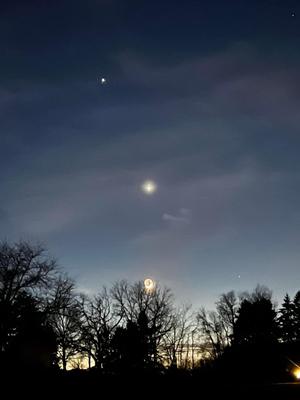Glossary term: Conjunción
Description: Desde la perspectiva de un observador en la Tierra, cuando dos objetos astronómicos parecen estar muy próximos en el cielo, se dice que están en conjunción. La conjunción no tiene que ser realmente visible; por ejemplo, la Luna y el Sol están aproximadamente alineados siempre que hay Luna nueva, pero no podemos ver la Luna en esas condiciones, a menos que haya un eclipse solar. En ese caso, y siempre que una conjunción esté tan cerca que un objeto parezca cubrir al otro, los astrónomos lo describen como un tránsito o un eclipse.
Related Terms:
See this term in other languages
Term and definition status: The original definition of this term in English have been approved by a research astronomer and a teacher The translation of this term and its definition is still awaiting approval
The OAE Multilingual Glossary is a project of the IAU Office of Astronomy for Education (OAE) in collaboration with the IAU Office of Astronomy Outreach (OAO). The terms and definitions were chosen, written and reviewed by a collective effort from the OAE, the OAE Centers and Nodes, the OAE National Astronomy Education Coordinators (NAECs) and other volunteers. You can find a full list of credits here. All glossary terms and their definitions are released under a Creative Commons CC BY-4.0 license and should be credited to "IAU OAE".
If you notice a factual or translation error in this glossary term or definition then please get in touch.
Related Media
Jupiter, Venus, Moon Conjunction
Credit: Joslynn Appel/IAU OAE (CC BY 4.0)
License: CC-BY-4.0 Creative Commons Reconocimiento 4.0 Internacional (CC BY 4.0) icons
Moon-Mercury-Pleiades Conjunction
Credit: Giulio Colombo/ IAU OAE
License: CC-BY-4.0 Creative Commons Reconocimiento 4.0 Internacional (CC BY 4.0) icons










